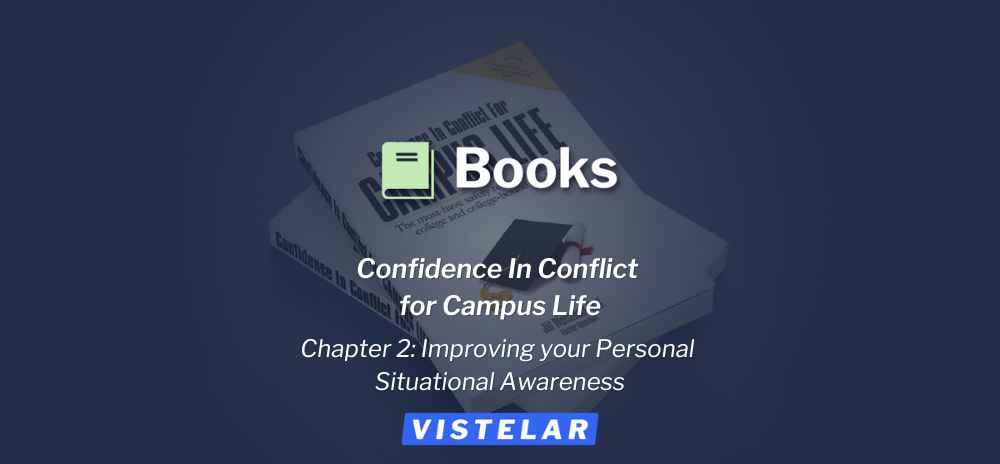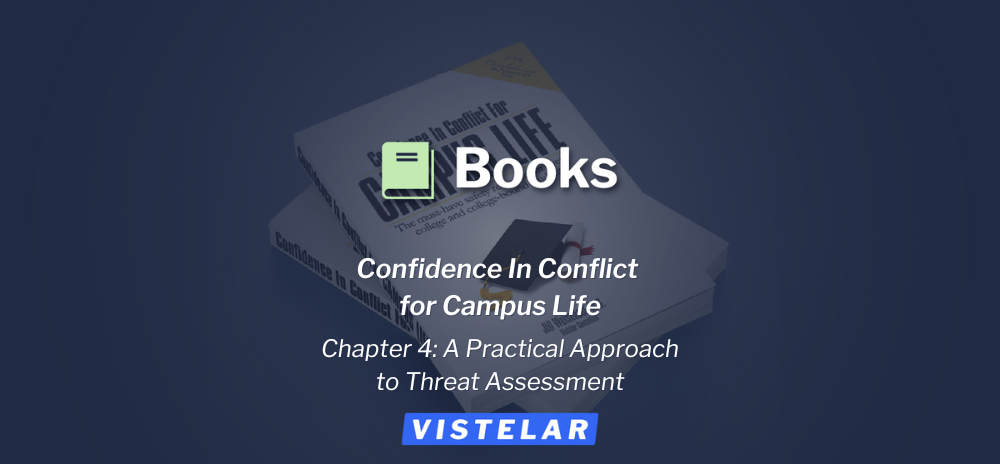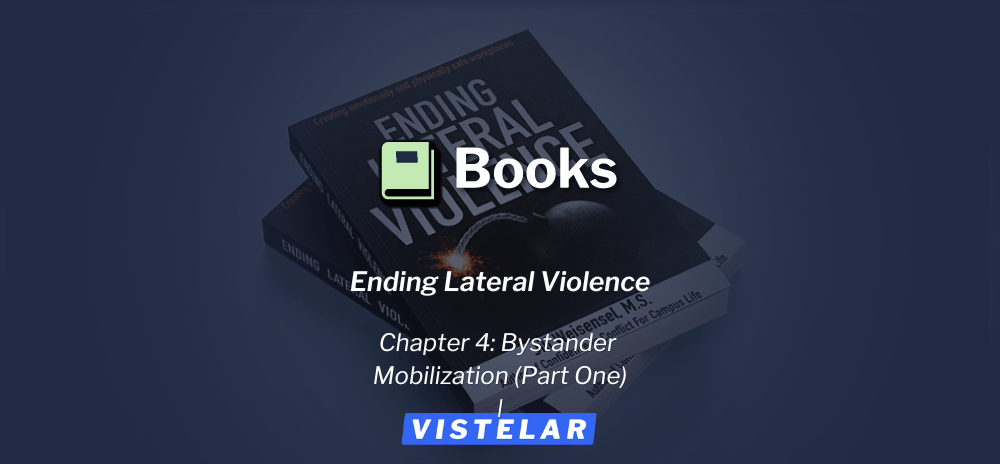Enjoy this excerpt from one of our published books.
Chapter 2
Improving Your Personal Situational Awareness
After six hours of unloading her stuff and setting up her new dorm room, Amanda was exhausted. She was super excited that she finally had her own desk, her own bed, and her own space. She looked over at her laptop and iPod and noticed that her music download was finally complete. As she sat down on her futon, she heard a knock on her door. “That must be my roommate,” she thought. Nervous to meet her, Amanda quickly opened the door. “Hi, I’m Jordan. I live here too.”
Amanda looked at her new roommate in complete disbelief. Jordan was wearing dingy looking sports clothes, and smelled like she had just finished playing a la-crosse game. Jordan hardly had anything with her- just a backpack and a duffel bag. “Hi. Um… it’s… nice…to meet you. I was just about to head to the cafeteria with some friends. If you leave later, could you please lock the door?” “Yeah, whatever. Later,” said Jordan.
With Amanda gone, Jordan plunked down on her futon and debated whether or not she wanted to start setting up her stuff. “Nah,” she thought. “I’m going to go check out this campus, it’s huge.” As Jordan left, she glanced over at Amanda’s new laptop, noticed her iPod, and then scoped out all of her designer brand clothes. “Dang, the girl’s got cash. She won’t miss this.” Jordan then took Amanda’s iPod, left their dorm room door unlocked, and headed out to scope the campus for some place to eat.
Theft happens just that fast. On a college campus theft is usually committed by the people you’d least expect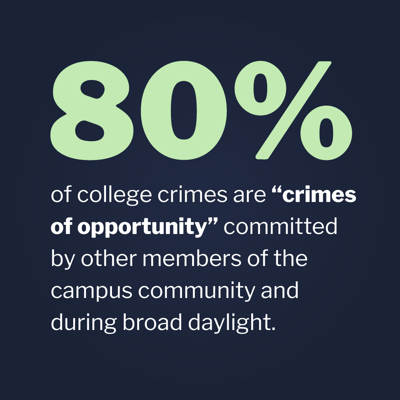 to steal from you. In fact, over 80% of college crimes are “crimes of opportunity” committed by other members of the campus community and during broad daylight. A crime of opportunity simply means that the crime was committed because there was an opportunity for someone to get away with it. In other words, most of the time clothes, wallets, purses, bikes, cell phones, and laptops are stolen when they are left unsecured and unattended! Stealing something doesn’t get any easier than someone leaving their property unattended, even if it’s “just for a minute.” I can’t tell you how many police reports I have read that said, “The victim’s unsecured and unattended property was stolen. The victim stated he walked away from his study table to go to the bathroom. When he returned to his table, his laptop was gone.” As a rule of thumb, never leave anything unlocked or unattended that you can’t afford to replace. Even more than that, think about the things that could get stolen that are irreplaceable, such as a gift from a parent or grandparent that has passed away, or a hard drive containing your final project. In terms of securing your personal property, it is always better to be safe than sorry. So what about Amanda’s iPod? How could she have prevented it from being stolen?
to steal from you. In fact, over 80% of college crimes are “crimes of opportunity” committed by other members of the campus community and during broad daylight. A crime of opportunity simply means that the crime was committed because there was an opportunity for someone to get away with it. In other words, most of the time clothes, wallets, purses, bikes, cell phones, and laptops are stolen when they are left unsecured and unattended! Stealing something doesn’t get any easier than someone leaving their property unattended, even if it’s “just for a minute.” I can’t tell you how many police reports I have read that said, “The victim’s unsecured and unattended property was stolen. The victim stated he walked away from his study table to go to the bathroom. When he returned to his table, his laptop was gone.” As a rule of thumb, never leave anything unlocked or unattended that you can’t afford to replace. Even more than that, think about the things that could get stolen that are irreplaceable, such as a gift from a parent or grandparent that has passed away, or a hard drive containing your final project. In terms of securing your personal property, it is always better to be safe than sorry. So what about Amanda’s iPod? How could she have prevented it from being stolen?
First of all, Amanda poorly judged the situation. She left her property unattended with someone she had never met. She also trusted that person to lock up her room after she left. What if someone else came into their unlocked room after Jordan left? This is a very common way for TVs, DVDs, video game consoles, video games, and textbooks to get stolen. If Amanda had been utilizing when-then thinking, she would have thought about what she could do to prevent her iPod from being stolen, and about what she could do to make sure she got it back if it was stolen. The answer to the first question is easy: she shouldn’t have left her iPod easily accessible and unattended with someone she didn’t know. The answer to the second question is a little more difficult: she could have had her initials or a code word etched into the back of the iPod, so that if it was recovered by law enforcement personnel and found amongst Jordan’s property, Amanda could prove it was hers.
Becoming a when-then thinker is just the first step to improving your personal situational awareness. The next step is to gain a better understanding of your “personal level of awareness,” which is in essence your overall level of alertness. This also includes your overall understanding of the inherent dangers and resources available to you within your environment. Think of this like your own personal protection radar system.
Personal Levels of Awareness
To better explain this concept, I will reference world renowned tactical trainer Colonel Jeff Cooper’s “Color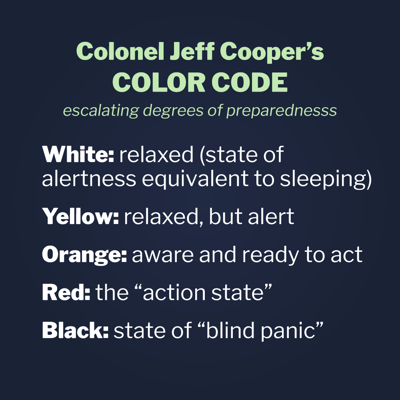 Code,” that has been used by law enforcement and military instructors for many years to describe “escalating degrees of preparedness” and alertness at any given time. While the Color Code model was originally intended for potentially combative and deadly force shooting incidents, public safety officials have universally adapted it to use as a gauge for all types of situations you may encounter.
Code,” that has been used by law enforcement and military instructors for many years to describe “escalating degrees of preparedness” and alertness at any given time. While the Color Code model was originally intended for potentially combative and deadly force shooting incidents, public safety officials have universally adapted it to use as a gauge for all types of situations you may encounter.
The first condition of awareness is known as “Condition White.” In Condition White, you are generally relaxed, and for the most part, unaware of what is going on around you and in your environment. Condition White is often referred to as a state of alertness equivalent to that of sleeping, meaning you’re pretty much oblivious to everything happening around you. You are the most likely to become a victim of a crime if you’re always living in Condition White.
Few of us intend to be in Condition White, but a lot of our behaviors can move us there. Being overtired, consuming drugs or alcohol, walking while texting, or walking with your headphones on— all of those things can impact your ability to “take in” information from your senses that can give you an accurate assessment as to how safe your environment is. Ideally, you should rarely, if ever, be in Condition White while on campus. If you were in Condition White and attacked, the attack would come as a total surprise to you, and you would not have any pre-planned response in mind. This would most likely result in complete panic.
The second condition of awareness is known as “Condition Yellow.” In Condition Yellow, you remain relaxed, but you are now aware of who and what is around you. Think “relaxed, but alert.” This sim- ply means that you are now paying attention to all of the sights, smells, and sounds that surround you. It means that you have changed your level of alertness to recognize the actions of people around you, and you have started to casually think about how they could impact you and how you’d respond if something happened.
For example, if you were in Condition Yellow, you would start keeping track of people who were walking behind you and you would notice if they started following you when you turned a corner or entered a building. You would start to notice the sound of their footsteps quickening if they were trying to catch up to you, while also looking for a close public or private place that you could enter quickly so that you could get closer to people and away from danger. Some other examples of Condition Yellow thinking would include scanning for exits when entering a new building, or picking a seat in a theater or restaurant that would allow you to keep an eye on who may be entering the building. A great practical example of when-then thinking and Condition Yellow awareness would to be mindful of the time so that you can drive home safely on a Friday or Saturday night and get home before “bar close,” which would increase the possibility of intoxicated drivers on the road.
The third condition of awareness is “Condition Orange.” Condition Orange means that you have again escalated your level of alertness from just being “aware,” to “being ready to act.” In Condition Orange, you will have the ability to identify something of interest to you that may or may not prove to be a threat to you. Whatever that “something” is that you have identified as a possible threat, you will remain focused on it and will investigate it further to determine if it is a danger or not. If you identify someone or something that looks out of place or just doesn’t “feel right,” you should shift from 540 degree awareness, to a more focused awareness towards that danger, which will help you ascertain the true nature of the situation. In the example above, if you suddenly realized that you were being followed, you would start scanning for an area that had more light, more sound, and/or more people, and make a plan to head that way immediately. If you duck into a convenience store or head into a student common area, you can find safety amongst other students and see if the person following you was truly a threat. If they aren’t, you have lost nothing, but at least you put yourself into a better position if in fact that per- son was a threat.
The fourth condition of awareness is “Condition Red.” If you are scanning in Condition Orange and become aware of something that you have confirmed truly is a threat, you will move into Condition Red, which is also understood as the “action state.” In this state, you will have specifically identified something you need to protect yourself against, and you will follow through with one of your mentally prepared when-then responses. In the example above, you would have already changed your course from walking home and would have made the decision to stop inside the convenience store, but you would also go a step further and perhaps let the store clerk know that you believe you’re being followed and ask them to contact campus security.
There is a final condition of awareness that is referred to as “Condition Black.” While not a part of Jeff Cooper’s original model, I’m sure by now you can guess what level of alertness this is. Being the exact opposite of Condition White, Condition Black has often been referred to as the state of “blind panic.” This would mean that something was happening to you or someone approached you that presented such a threat to your life that your body would immediately kick into a “fight or flight” response. This Condition would render you incapable of rational thought, and without proper training or sufficient experience, you would most likely “freeze,” and be unable to respond to the situation. In our example above, if you were walking home at 2am, slightly intoxicated and looking down at your text messages (Condition White), and you were suddenly followed, grabbed, and were being robbed at gunpoint, your mind and body would most likely kick into a Condition Black panic.
One of the things to remember about the conditions of awareness is that they are fluid. You can move from one condition to another multiple times a day, or throughout a specific incident. It is possible to go right from Condition White to Condition Black (which is obviously not going to go well). It is also possible to be in Condition Yellow and hear something warranting concern, such as a woman screaming, moving you to Condition Orange or Condition Red, only to find out that the woman wasn’t actually screaming out of fear, she was just shouting towards a friend who had forgotten something on the roof of his car and was driving away. This would move you back to Condition Yellow. This is just one example of how you can move through the conditions of awareness and use the Color Code strategy to evaluate your level of alertness. Try and think of situations and examples that you have already been in where this would have come in handy and perhaps helped the situation end differently.
Now that you have adopted the “scan and observe” mentality and understand the conditions of awareness, you will also need to learn how to trust your gut instincts. If something feels like it is out of place or you feel like you could be in danger, you need to trust your gut! Students often tell me that they don’t know what dangerous cues to look for. We describe these cues as “red flags,” which are basically risk indicators for things that make you more vulnerable to bad things happening, such as crimes, accidents, or medical emergencies. The better you are at identifying red flags, the better you will be at trusting your gut and avoiding potentially dangerous situations.
So What Exactly Is a Red Flag?
Red flag risk indicators vary depending on the environment. Think about the situations and places you will most likely find yourself in, and identify the warning signs. Any one warning sign doesn’t necessarily mean you are in danger, but the totality of several may. Think about it like this: no one or two red flags should be considered in isolation, you should be assessing the totality of indicators to understand. Understand what they are, and what you can do to avoid or change them. We would like you to reduce your risk of being victimized— understanding red flag risk indicators and working to avoid them is a great risk reduction strategy! For example, here are some of the red flag risk indicators for a few common crimes on campus:
Bike Theft
A bicycle on campus is more likely to be stolen if:
- It is left unsecured in a bike rack or on a porch.
- It is secured with just a cable lock.
- It is secured with a cable lock, but only through the front tire.
- It is secured, but left unattended for long periods of time in a low lit, rarely traveled area.
- It isn’t registered with the local police or campus security.
A bicycle on campus is less likely to be stolen if:
- It is properly secured with a “U-bolt” style lock.
- It is secured in a well-lit, well-traveled, well patrolled area.
- It is labeled or etched with a bike registration/recognition program with local police or campus security.
Burglary
An apartment on campus is more likely to be burglarized if:
- It is Spring Break or a holiday break and no one is around.
- It is located on a corner.
- It has multiple windows (entry points) on the first floor.
- The tenants continually leave the doors unlocked or open.
- The tenants leave boxes or packaging from high dollar items such as laptops and TVs in the garbage out in front or back of the apartment/house.
- The tenants post on social media when they will be gone on vacation.
An apartment on campus is less likely to be burglarized if:
- The tenants keep the windows and doors on the first floor closed and locked.
- The tenants are mindful not to post on social media the days, times, and locations of their vacations.
- The tenants only host parties including friends they know well.
- The tenants do their best not to attract attention to their valuables by leaving boxes and packaging visible in their garage.
Armed Robbery
An individual is more likely to be robbed if:
- They are walking in an unfamiliar place or in a high crime area
- They are walking alone and/or in the dark
- They aren’t paying attention to their surroundings, such as by texting or listening to their headphones.
- They aren’t paying attention to their surroundings as a result of being intoxicated or impaired by drugs.
- They have high dollar items, such as jewelry, purses, cell phones, or MP3 players externally visible.
An individual is less likely to be robbed if:
- They pay attention to their surroundings by walking to and from destinations with their headphones off and their cell phones in their pockets.
- They walk in pairs or in groups and take the most direct route to and from a location.
- They avoid walking through high crime areas.
- They choose to utilize their campus transport or escort services.
As you can see, red flag risk indicators are different depending on the situation and the location. To be able to notice these indicators, you need to be at the appropriate level of awareness. Now that I gave you a few examples, see if you can come up with some on your own by using when-then thinking in your own real-life situation. Think of a time when something didn’t go as planned. Were there any signs that things were about to go wrong? If so, what could you have done to prevent them? What would you do differently in the future that could prevent that from happening again?
“While it is important to have a pre-planned, practiced response in mind, if you’re not paying attention, you will never see it coming!”
– Gary T. Klugiewicz



